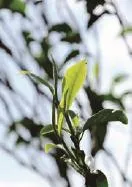A TASTE FROM THE SPOUTS
2017-04-10LanXiaojiang,BianJiajin,Yishan等
A TASTE FROM THE SPOUTS
Lingnan has, for a long time been famous for tea production, and it is worldwide known that Cantonese have a liking for tea.
For people in the Lingnan area, tea is about a craft, a business, a culture, and it’s also a kind of lifestyle that suits both refi ned and popular tastes.
Text by Lan Xiaojiang Translation by Bian Jiajin&Yishan Photo by CFP & 东方IC & Huang FuyangCantonese love drinking tea; they also love “eating”with tea.

“Morning tea” can be the representative of Cantonese lifestyle. At the weekend, the old and renowned restaurants such as the Guangzhou Restaurant and Taotaoju Restaurant are always crowded with people coming for “morning tea”. Most of them are families with the elders and kids. They usually order a pot of Pu'er tea or Chrysanthemum tea, some steamed prawn dumplings, chicken claws, a plate of dry crystal noodles and a bowl of porridge, chatting and laughing, sharing the same tastes together. Cantonese lay much emphasis on family life and take family reunion into account, so there are no more important things than spending time with family on weekends.
Even on weekdays, tea houses are very busy. In earlier times, tea houses were for passing businessmen to rest. Thus, they were also called“one-mile houses”. Later, this kind of venue got more and more specifi ed, and the contents were more plentiful. They became the place for talking business as well. The passing tourists and businessmen were there getting together, discussing their ideas. In Lingnan, trades have been important since ancient times; the businessmen also needed places like tea houses allowing them time to communicate with each other. The place must not be too sophisticated, but should not be too casual. Thus tea houses, restaurants, tea rooms, tea lounges were born under the situation.
The types of tea on the tables of the Lingnan people are diverse, and their qualities are also different. In the Ming Dynasty, tea bushes were planted in an increasingly larger area. After the policy of One Treaty Port in the Qing Dynasty, teas from all over the country were collected in Guangzhou, being processed and distributed. Therefore, Cantonese also imported tea from other areas and cultivated their own types. In the Lingnan area there are home-grown 1000-year-old tea bushes such as “Red Monkey” and “Phoenix Dan-cong tea”, and also black tea originally from England and Germany was evolved into Yunnan black tea. The tea in Lingnan was once listed into one of the exporting commodities. During One Treaty Port period in the Qing Dynasty, Thirteen-Trades Monopoly were full of businessmen from inland and overseas, and the tea trade was an essential part of commerce. Chinese Tea was at that time regarded as the “green gold” for westerners, exported via Guangzhou to Europe, and then to America, British colonies and then fi nally spread over America.
With the development of trade and business and the Lingnan-style tea house culture, street cool herbal teas were further developed or created. And all kinds of new ways to make tea were initiated and evolved into more unique tea customs, of which the most famous would be “Kungfu tea” in the Chaozhou-Shantou region. “Kungfu“ in Chaozhou dialect means being extremely particular and honest about something. Enjoying “Kungfu Tea” is also a particular tea activity which requires exact tea picking, the right tools for tea making, the correct techniques and also the perfect way of tasting. Kungfu tea has even been a kind of “ceremony” in traditional culture. The Hakka area is famous for traditional tea from mountainous areas. People in the Hakka area have kept the “living fossil”—the technique of grinding tea, from the Jin Dynasty to now, and also a variety of historical tea songs, dances and related operas, which have formed another special culture different from the refi ned one in Guangzhou and in the Chaozhou-Shantou Region.
饮春芽
春天,是饮春茶的好季节。岭南历来盛产茶叶,广东人嗜饮茶更是中外闻名。茶叶在岭南人的手中,变成一种手艺,一门生意,一种文化,更成为一种闹中有静、雅俗共赏的生活方式。
广东人爱喝茶,更爱“吃”茶。
“早茶”几乎成了广式生活的代名词。每到周末,广州酒家、陶陶居等老字号里,就挤满了排队来喝早茶的人。多半是一个家庭,从老人到小孩,叫一壶普洱或菊花,再来几笼虾饺、凤爪、一碟肠粉、一碗粥,有说有笑,分甘同味。广州人重视家庭,没有什么比周末陪家人喝早茶更重要。
即便是工作日,茶楼里也是热闹非常。最早时,茶楼是给过路的商人歇脚的地方,又叫做“一厘馆”。后来,这样的场所越来越专业,内容越来越丰富,来往的客商开始聚集,便也成了谈生意的地方。岭南地区自古重商,商人们需要这种既能聚集又能交流,既不用太繁复又不会太随意的地方,各种茶室、茶馆、茶楼、茶寮相应而生。
岭南人茶桌上的茶叶品种繁多,品质价格也有高有低。岭南素来产茶,明代时期茶叶种植面积大大增加。清代一口通商后,全国各地的茶叶都汇聚在此,在广州进行加工和分装。于是,广东茶叶也引进了各地的茶种,培育出自己的特色。在岭南,既有本土生长的千年古树茶“猴采红”“凤凰单枞”,也有根据滇红改良的英德红茶。岭南的茶叶也曾一度列入出口行列。清廷实行“一口通商”时期,广州十三行商馆中西方商人云集,茶叶贸易是重要组成部分,中国的茶叶曾一度成为西方社会 “绿色的黄金”,从广州传入欧洲,接着传入当时为英属殖民地的美国,继而传遍了美洲大陆。
随着商业贸易的推进,岭南特色的茶楼文化、街头凉茶文化衍生发展。各种泡茶方法应运而生,更形成了特有的茶俗文化,其中,尤以潮汕“功夫茶”最为著称。“功夫”在潮语意中喻意做事考究、用心。品功夫茶是一件很讲究的茶事活动,对茶叶、茶具、冲沏手法、品评都有要求,把品茶上升到“礼”的程度。客家地区则以山地茶传统闻名,保存有晋朝前流传下来的“活化石”擂茶,还有各种历史悠久的茶歌 (客家山歌)、茶舞和采茶戏剧,形成了有别于广州、潮汕精细茶文化的另一种特色。

FENG-HUANG (PHOENIX) DAN-CONG TEA, CHAOZHOU CITY
潮州凤凰单枞茶
One of the three major tea production regions of oolong tea and the origin place of the “feng-huang suhi-xian (phoenix narcissus)” tea tree. The selected “feng-huang shui-xian” tea trees, after generations of development has gained the name of “feng-huang dan-cong” tea in the past 700 years and has become well-known around the country.
潮州是我国三大乌龙茶产区之一,国家级茶树 “凤凰水仙种”的原产地。数代茶农从凤凰水仙品种中分离筛选出来的众多品质优异的单株,即“凤凰单枞”。 潮州凤凰单枞茶,有700多年的生产历史,是国家级的名茶。

YING-DE BLACK TEA, YING-DE CITY
英德红茶
The tea planting in Ying-de can be dated back to 1,200 years before the Tang dynasty. Ying-de black tea, developed from the combination of Yun-nan da-ye tea and feng-huang shui-xian teas, was fi rstly established in 1959 and gained recognition as another major breed of Chinese black tea.
英德种茶历史可追溯到距今1200多年前的唐朝。英德红茶创建于1959年,是英德特产之一。所栽培的茶树以云南大叶与凤凰水仙两优良群体为基础,较之滇红、祁红别具风格。

XIAN-REN (THE IMMORTAL) TEA OF HUI-DONG CITY
惠东仙人茶
It is said to be panted by immortal Ge Hong in Hui-dong thousand years ago. Until now, the wilding tea trees only grow in few mountainous areas in Hui-dong city. The tea usually enters the market a couple of days before or after the Tomb Sweeping Day (Apr 4th of the lunar calendar). It can also serve as medicine for bad appetite or an upset stomach.
仙人茶传说是葛洪仙师亲手栽种,是惠东特产,传已有千年历史,仅在惠东多祝、白盆珠、高潭、宝口等高山地区野生生长。此茶上市时间为清明前后八九天,药理效果特好,可清热解暑,也可调节肠胃不适、厌食等。
BAI-MAO (WHITE HAIR) TEA, REN-HUA, SHAO-GUAN CITY
韶关仁化白毛茶
During the Qing Dynasty, bai-hao tea picked from Huang-ling Peak at Renhua county gained a name of “Yun-wu (cloud and fog) bai-hao” and was sent to the emperor Jiaqing for tribute. Until now, with thick buds and an elegant scent of the orchid, Ren-hua bai-mao ranks top among the three Chinese bai-mao teas.
仁化县是岭南白毛茶的故乡。仁化红山乡黄岭嶂的“云雾白毫”茶,曾是清代嘉庆朝的宫廷贡品。仁化白毛茶具有芽头肥硕、带兰花香味等特点,为我国三大白毛茶之首。


XIN-HUI JU-PU (ORANGE SKIN PLUS PU-ER), XIN-HUI CITY
新会橘普
As one of the three famous special products from Guangdong, Xin-hui ju-pu has gained recognition for its medical value. With the processed combination of pu-er tea leaves and fried orange skin, ju-pu has been famous for the use of facilitating digestion, reliving a cough, and reducing sputum.
陈皮作为广东三宝之一,药用价值早已得到广泛的认可。将有着“百年陈皮”美誉的新会陈皮与陈年普洱,经过特殊工艺结合在一起的橘普,可以助消化,止咳化痰,颇受茶客们青睐 。
